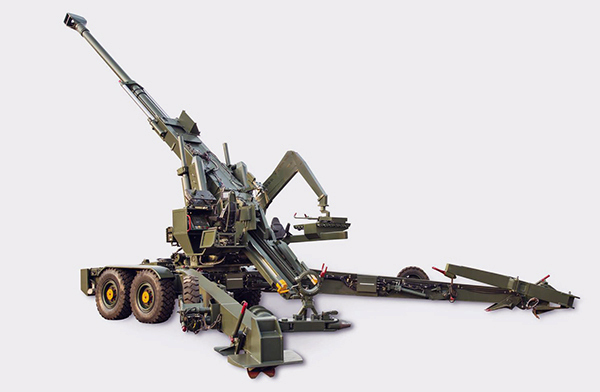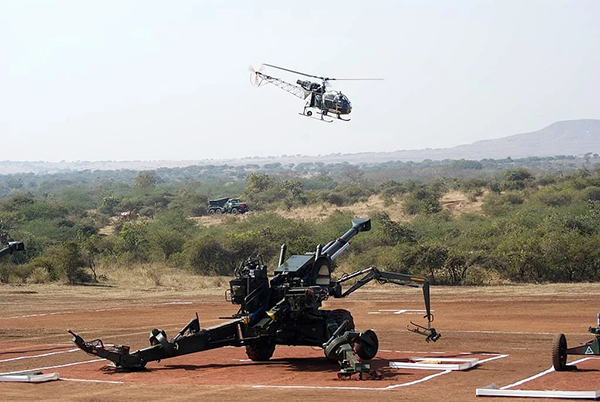Make in India Initiative Bearing Fruit
As part of Army’s artillery modernisation project, additions are being made to have longer range of rockets, loitering ammunition, UAVs with greater endurance besides newer indigenous guns. Artillery consists of guns, rockets, missiles and Unmanned Aerial Vehicles. It launches munitions far beyond the range and power of infantry firearms.
The Field Artillery Rationalization Plan, drawn up in 1999, talks about acquiring 2,800 guns by 2027. Meeting these numbers could take up to a decade or more from now.
All Gun systems procured in the last five years or being procured, apart from Ultra-Light Howitzer, are indigenous Gun Systems being manufactured in India.
The plan talks about having all guns at same level — 155 mm. These includes 1,580 towed guns, 814 truck-mounted guns, 100 tracked self-propelled guns,180 wheeled self-propelled guns and 145 ultra-light howitzers.
Last year on emergency procurement basis, the Ministry of Defence okayed purchase of loitering ammunition for Army. These are set to be delivered now. Loitering ammunition can remain in the air for a specified period, do surveillance of targets and strike when directed from ground.
Among the multiple type of guns being inducted, include the Advanced Towed Artillery Gun System (ATAGS), the Sharang, ULH, Vajra and Dhanush.


The firing trials of ATAGS have gone off well. The field evaluation trials have been completed. Tata and Bharat Forge, the two manufacturers of the DRDO designed gun are ready to start production – some 170 are expected to be made in the first batch. The Director General Quality Assurance (DGQA) is testing its efficacy against dust, rains, mould etc. In another two months things should move ahead.
The Ultra Light Howtizers – in all 145 imported from US—are being inducted steadily. Seven regiments – 18 guns in each – of ULH have been inducted and deployed.
Sharang – the 130 MM gun that is being up-gunned to 155 MM – has three operational regiments, one more is on the way. In all 300 guns are to be up-gunned. The current speed of up-gunning is two regiments per year. We need to speed up to do three regiments per year.
The success of the K9 Vajra gun – that runs of tank-style tracks – in eastern Ladakh has led to the MoD okaying the purchase of 100 more such guns. Originally the gun was made for the desert sector; its adaption for Himalayan winter includes batteries that work in cold and lubricants that don’t freeze.
The first regiment of Dhanush has been deployed, the second one is expected by March 2023.
The future of long artillery includes long-range rockets. A 75 km range guided rockets that can fire from Pinaka launcher are to be inducted. The multi-barrel ‘Smerch’ can fire for 90 km range. The DRDO has been asked to work at rocket that can fire 125 km.
One of the four Pinaka regiments have been inducted along Northern borders. Six more Pinaka regiments have been contracted and delivery was expected soon and would be equipped with electronic and mechanical weapon system capable of firing variety of ammunition over longer ranges.
With long range rockets being inducted, aerial surveillance is need to find targets. The Army is looking for vertically launched drones with 80 km range. The system will direct fire in enemy areas including beyond visual range.
Make in India Initiative
The modernisation of the Artillery of the Indian Army has gathered momentum with several important projects in the pipeline. And guns made in India are now being operationalised in the high altitude areas along the northern borders and along Line of Control.
The focus of this whole process has been on indigenisation under the Make in India initiative, this means now all the gun systems being used by the Indian Army in the last five years have been designed and developed in the country except the Ultra-Light Howitzer.
Dhanush
In 2019, the Indian Army had signed a deal to procure 114 Dhanush 155 mm/45-calibre towed howitzers. By March 2023 the Army is expected to induct the second regiment of this gun.
These guns which have a strike range of 38 km have already been inducted in the Indian Army which has got 18 of them so far. These guns which were manufactured at the erstwhile Jabalpur-based Gun Carriage Factory (GCF), at a cost of Rs 14.50 crore, and each shell at Rs 1 lakh, are already active along the borders of China and Pakistan.
With this gun Indian Army’s fire power has been augmented and paved the way for development of private gun manufacturing industry in India. The factory already has Bulk Production Clearance (BPC) for the production of 114 Dhanush, country’s first indigenous 155mm x 45 calibre artillery gun.
Before induction the gun had undergone trials and tests under extreme conditions in different phases in terrains like Leh, Sikkim, Balasore, Odisha, and Babina in Jhansi.
So far the indigenous material in this gun is around 90 percent and the private as well as public sector has been part of this project and these include: SAIL, BEL and OFB. The Indian Army, Defence Research and Development Organisation (DRDO) and DGQA are all part of this project.
This gun has been mechanically and electronically upgraded on the basis of the first phase of Transfer of Technology (ToT) deal under the Bofors contract of the 1980s.
K-9 Vajra
Amidst the ongoing border standoff between the troops of Indian and Chinese armies since May 2020 in eastern Ladakh, the K9-Vajra self-propelled howitzer which weighs around 50 tonnes has been deployed by the Indian Army. These guns which are capable of firing 47-kg of bomb at the higher altitude have been deployed to help the Army to strengthen its position against the enemy.
So far 100 K9 Vajra gun systems have been inducted and recently, DAC headed by defence minister Rajnath Singh has already given its approval for procurement of additional 100 K9 Vajra. And the process is set rolling and the Request for Proposal is going to be sent out soon.
Since these guns are already inducted in the army, there will be no further trials, now the vendor just has to submit the commercial bid and based on that the cost negotiations will take place.
These 155mm/52 calibre guns which have a striking capability of 50 km have been made at the Armoured Systems Complex of Larsen and Toubro (L&T) located in Gujarat. It is under the ‘Make in India’ initiative at a cost of Rs 4,500 crore.
In 2017, L&T had won the Rs 4,500-crore contract to supply 100 units of K9 Vajra under the ‘Make in India’ initiative for which it signed a transfer of technology contract with South Korean company Hanwha Corporation. According to L&T, K9 Vajra are delivered with more than 80 per cent indigenous work packages and above 50 per cent indigenisation (by value) at the programme level.
Sharang
This 130 mm gun system with a life and technology enhancement has a better accuracy, range, and consistency corroborating Indigenous Defence Capability.
The Army is getting prepared to get the 4th Regiment. The total volume required is 300 and this is expected to be completed in a year’s time. The source added that 15 Regiments are to be equipped with the Sharangs.
Pinaka Weapon System
The indigenous more advanced Pinaka weapon systems are in offing. A contract for six more regiments have been signed by the Army and soon the delivery will start. And these six regiments are going to be equipped with mechanically and electronically improved weapon systems which are capable of firing different ammunition over longer ranges.
The Army depends on Grad Multi Barrel Rocket launchers. Presently it has five regiments and Smerch which has been procured from Russia. But, the indigenous Pinaka has been a great success, not only in terms of launchers but also in bouquet of ammunition.
There will be trials for extended range of the Pinaka and the plan is to increase its range. With the help of the DRDO the Army is exploring the possibility of extending the range to 100-125 kms.
In response to Chinese positioning of its artillery, the Indian Army has deployed one regiment of the Pinaka Rocket System along the Line of Actual Control in the northern borders.
ATAGS
These are in the advanced stages of trials. And have been designed and developed through a partnership between DRDO and the domestic industry. This system has many firsts to its credit, said the source. It has a 25 litre chamber, long range, and sustained and rapid rates of fire. The user trials so far have been satisfactory and few procedural issues are in the midst of being taken care of.
Ultra-Light Howitzers M777
These have already been validated in the Ladakh and Arunachal Pradesh regions. So far there are no plans to procure more of these Ultra-Light Howitzers. So far India bought 145 ULH at US $ 750 million from the US to address specific operational requirements in specific sectors especially in the high altitude areas of northern borders and other tough terrains. These 155 mm/39-caliber M777 howitzers have a range of up to 30km. And they are capable of carrying out strikes at ranges of over 40 km in some areas.













